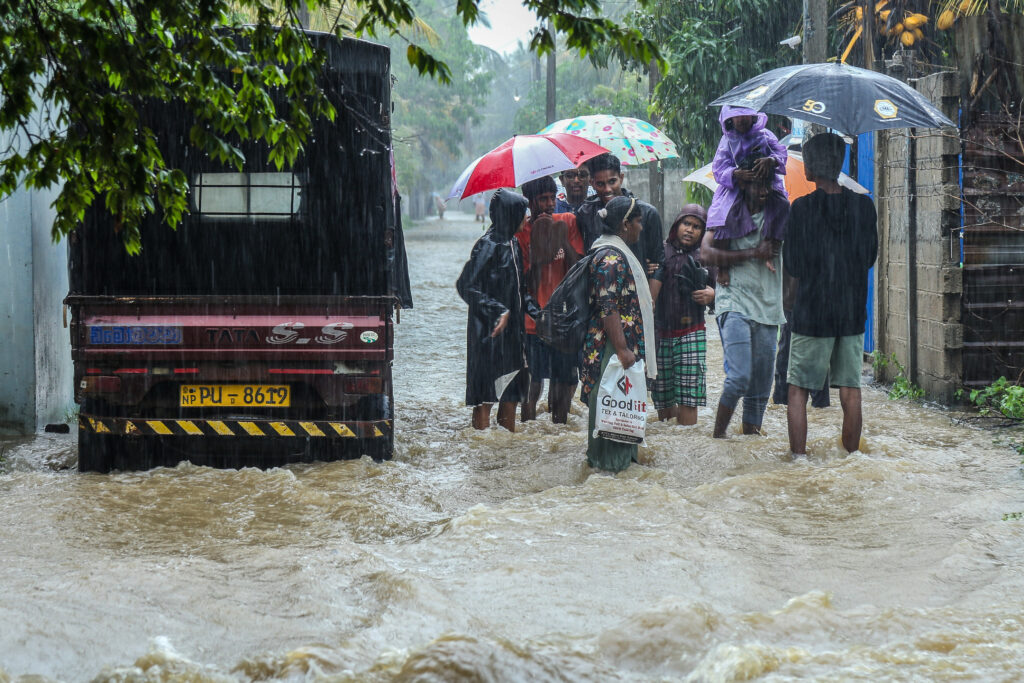Sri Lankan authorities deployed the military for relief and rescue operations Friday as the death toll from floods and landslides rose to 56, with another 21 people listed as missing.Helicopters, navy boats and armoured personnel carriers are being used to evacuate marooned villagers in several parts of the country, the Disaster Management Centre (DMC) said, as the rain continued.The island’s entire 65,000-square-kilometre (25,000-square-mile) area is experiencing rainfall, with some regions seeing 360 millimetres in the past 24 hours, the DMC said.Of the 56 people confirmed dead, 26 were buried alive in mudslides in the tea-growing Badulla district in the central region of the island, it added.Twenty-one people were listed as missing, while another 14 were hospitalised.The DMC said a cyclonic storm named “Ditwah” was moving across the island’s eastern region, resulting in heavy rains across the country.The system is expected to move northwards towards neighbouring Tamil Nadu state in India by Sunday.”Due to the influence of this system, the prevailing heavy showers and strong winds over the island are expected to continue,” the DMC said.Nearly 700 homes were damaged in mudslides and floods, with almost 1,800 families moved to temporary shelters.The DMC said river levels were rising across Sri Lanka and warned residents in low-lying areas to move to higher ground.Sri Lanka is currently experiencing the northeast monsoon season, but rainfall has intensified due to the cyclone, it added.The government suspended final-year school examinations nationwide for two days because of the weather. Civil servants were given a day off.Sri Lanka’s parliament also suspended its budget debate so that legislators could return to their constituencies to deal with the damage.This week’s weather-related toll is the highest since June last year, when 26 people were killed following heavy rains. In December, 17 people were killed by flooding and landslides.The worst flooding this century occurred in June 2003, when 254 people were killed.Sri Lanka depends on seasonal monsoon rains for irrigation and hydroelectricity, but experts have warned that the country faces more frequent floods due to climate change.
Sri Lankan authorities deployed the military for relief and rescue operations Friday as the death toll from floods and landslides rose to 56, with another 21 people listed as missing.Helicopters, navy boats and armoured personnel carriers are being used to evacuate marooned villagers in several parts of the country, the Disaster Management Centre (DMC) said, as the rain continued.The island’s entire 65,000-square-kilometre (25,000-square-mile) area is experiencing rainfall, with some regions seeing 360 millimetres in the past 24 hours, the DMC said.Of the 56 people confirmed dead, 26 were buried alive in mudslides in the tea-growing Badulla district in the central region of the island, it added.Twenty-one people were listed as missing, while another 14 were hospitalised.The DMC said a cyclonic storm named “Ditwah” was moving across the island’s eastern region, resulting in heavy rains across the country.The system is expected to move northwards towards neighbouring Tamil Nadu state in India by Sunday.”Due to the influence of this system, the prevailing heavy showers and strong winds over the island are expected to continue,” the DMC said.Nearly 700 homes were damaged in mudslides and floods, with almost 1,800 families moved to temporary shelters.The DMC said river levels were rising across Sri Lanka and warned residents in low-lying areas to move to higher ground.Sri Lanka is currently experiencing the northeast monsoon season, but rainfall has intensified due to the cyclone, it added.The government suspended final-year school examinations nationwide for two days because of the weather. Civil servants were given a day off.Sri Lanka’s parliament also suspended its budget debate so that legislators could return to their constituencies to deal with the damage.This week’s weather-related toll is the highest since June last year, when 26 people were killed following heavy rains. In December, 17 people were killed by flooding and landslides.The worst flooding this century occurred in June 2003, when 254 people were killed.Sri Lanka depends on seasonal monsoon rains for irrigation and hydroelectricity, but experts have warned that the country faces more frequent floods due to climate change.
